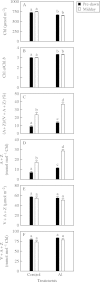Effects of aluminum on light energy utilization and photoprotective systems in citrus leaves
- PMID: 15829508
- PMCID: PMC4246804
- DOI: 10.1093/aob/mci145
Effects of aluminum on light energy utilization and photoprotective systems in citrus leaves
Abstract
Background and aims: Under high photon flux, excitation energy may be in excess in aluminum (Al)-treated leaves, which use a smaller fraction of the absorbed light in electron transport due to decreased CO2 assimilation compared with normal leaves. The objectives of this study were to test the hypothesis that the antioxidant systems are up-regulated in Al-treated citrus leaves and correlate with protection from photoxidative damage, and to test whether xanthophyll cycle-dependent thermal energy dissipation is involved in dissipating excess excitation energy. *
Methods: 'Cleopatra' tangerine seedlings were fertilized and irrigated daily for 8 weeks with quarter-strength Hoagland's nutrient solution containing Al at a concentration of 0 or 2 mM from Al2(SO4)3.18H2O. Thereafter, leaf absorptance, chlorophyll (Chl) fluorescence, Al, pigments, antioxidant enzymes and metabolites were measured on fully expanded leaves. *
Key results: Compared with control leaves, energy was in excess in Al-treated leaves, which had smaller thermal energy dissipation, indicated by non-photochemical quenching (NPQ). In contrast, conversion of violaxanthin (V) to antheraxanthin (A) and zeaxanthin (Z) at midday increased in both treatments, but especially in Al-treated leaves, although A + Z accounted for less 40 % of the total xanthophyll cycle pool in them. Activities of superoxide dismutase (SOD), ascorbate peroxidase (APX), monodehydroascorbate reductase (MDAR), dehydroascorbate reductase (DHAR), glutathione reductase (GR) and catalase (CAT), and concentrations of ascorbate (AsA), dehydroascorbate (DASA), reduced glutathione (GSH) and oxidized glutathione (GSSG) were higher in Al-treated than in control leaves. *
Conclusions: These results corroborate the hypothesis that, compared with control leaves, antioxidant systems are up-regulated in Al-treated citrus leaves and protect from photoxidative damage, whereas thermal energy dissipation was decreased. Thus, antioxidant systems are more important than thermal energy dissipation in dissipating excess excitation energy in Al-treated citrus leaves.
Figures




Similar articles
-
Both xanthophyll cycle-dependent thermal dissipation and the antioxidant system are up-regulated in grape (Vitis labrusca L cv Concord) leaves in response to N limitation.J Exp Bot. 2003 Sep;54(390):2165-75. doi: 10.1093/jxb/erg220. Epub 2003 Jul 28. J Exp Bot. 2003. PMID: 12885856
-
Effects of manganese-excess on CO2 assimilation, ribulose-1,5-bisphosphate carboxylase/oxygenase, carbohydrates and photosynthetic electron transport of leaves, and antioxidant systems of leaves and roots in Citrus grandis seedlings.BMC Plant Biol. 2010 Mar 7;10:42. doi: 10.1186/1471-2229-10-42. BMC Plant Biol. 2010. PMID: 20205939 Free PMC article.
-
Aluminum-induced decrease in CO2 assimilation in citrus seedlings is unaccompanied by decreased activities of key enzymes involved in CO2 assimilation.Tree Physiol. 2005 Mar;25(3):317-24. doi: 10.1093/treephys/25.3.317. Tree Physiol. 2005. PMID: 15631980
-
Energy transfer reactions involving carotenoids: quenching of chlorophyll fluorescence.J Photochem Photobiol B. 1996 Oct;36(1):3-15. doi: 10.1016/S1011-1344(96)07397-6. J Photochem Photobiol B. 1996. PMID: 8988608 Review.
-
The occurrence of red and yellow autumn leaves explained by regional differences in insolation and temperature.New Phytol. 2019 Dec;224(4):1464-1471. doi: 10.1111/nph.15900. Epub 2019 Jun 11. New Phytol. 2019. PMID: 31070794 Review.
Cited by
-
Low pH effects on reactive oxygen species and methylglyoxal metabolisms in Citrus roots and leaves.BMC Plant Biol. 2019 Nov 6;19(1):477. doi: 10.1186/s12870-019-2103-5. BMC Plant Biol. 2019. PMID: 31694545 Free PMC article.
-
Effects of High Toxic Boron Concentration on Protein Profiles in Roots of Two Citrus Species Differing in Boron-Tolerance Revealed by a 2-DE Based MS Approach.Front Plant Sci. 2017 Feb 17;8:180. doi: 10.3389/fpls.2017.00180. eCollection 2017. Front Plant Sci. 2017. PMID: 28261239 Free PMC article.
-
Effect of aluminium toxicity on GI tagged Kachai lemon seedlings.Physiol Mol Biol Plants. 2024 Dec;30(12):2065-2075. doi: 10.1007/s12298-024-01536-4. Epub 2024 Dec 8. Physiol Mol Biol Plants. 2024. PMID: 39744319
-
Aluminium stress tolerance by Citrus plants: a consolidated review.Physiol Mol Biol Plants. 2024 May;30(5):705-718. doi: 10.1007/s12298-024-01457-2. Epub 2024 May 27. Physiol Mol Biol Plants. 2024. PMID: 38846464 Free PMC article. Review.
-
Low pH-responsive proteins revealed by a 2-DE based MS approach and related physiological responses in Citrus leaves.BMC Plant Biol. 2018 Sep 12;18(1):188. doi: 10.1186/s12870-018-1413-3. BMC Plant Biol. 2018. PMID: 30208853 Free PMC article.
References
-
- Adams WW, Demmig-Adams B, Verhoeven AS, Barker DH. 1994. ‘Photoinhibition’ during winter stress: involvement of sustained xanthophyll cycle-dependent energy dissipation. Australian Journal of Plant Physiology 22: 261–276.
-
- Asada K. 1999. The water–water cycle in chloroplasts: scavenging of active oxygens and dissipation of excess photons. Annual Review of Plant Physiology and Plant Molecular Biology 50: 601–639. - PubMed
-
- Bilger W, Björkman OB. 1990. Role of the xanthophyll cycle in photoprotection elucidated by measurements of light-induced absorbance changes, fluorescence and photosynthesis in leaves of Hedera canariensis Photosynthesis Research 25: 173–185. - PubMed
-
- Chen L-S, Cheng L. 2003. Both xanthophyll cycle-dependent thermal dissipation and the antioxidant system are up-regulated in grape (Vitis labrusca L. cv. Concord) leaves in responses to N limitation. Journal of Experimental Botany 54: 2165–2175. - PubMed
-
- Chen L-S, Qi Y-P, Smith BR, Liu X-H. 2005. Aluminum-induced decrease in CO2 in citrus seedlings is unaccompanied by decreased activities of key enzymes involved in CO2 assimilation. Tree Physiology 25: 317–324. - PubMed
Publication types
MeSH terms
Substances
LinkOut - more resources
Full Text Sources
Medical
Miscellaneous

